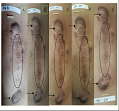Effect of essential oil on hypertrophic scars

Downloads
Additional Files
Background: Hypertrophic scars are abnormal scars resulted from a disrupted wound healing process. Hypertrophic scars can affect the body aesthetic of the sufferers, but, on the other hand, conventional therapy has not been optimally effective. The application of essential oil combinations as an alternative therapy for hypertrophic scars has not been scientifically proven.
Purposes: This study was to determine the effectiveness of the essential oil as a hypertrophic scar therapy.
Methods: This study used a pre and post-test design. As many as 24 subjects aged 17-25 years with hypertrophic scars were given essential oil combinations every morning and evening for six months. Assessment of hypertrophic scars was done using the POSASÂ (Patient and Observer Scar Assessment Scale).
Results: The results showed that the POSAS score decreased after the essential oil combination administration for six months, 14.40±6.08 vs. 22.67±8.31 (p<0.001).
Conclusion: the combination of essential oil oils used in this study reduces hypertrophic scars based on the POSAS assessment.Authors retain copyright and grant the journal right of first publication with the work simultaneously licensed under a Creative Commons Attribution-NonCommercial 4.0 International License that allows others to share the work with an acknowledgement of the work's authorship and initial publication in this journal.
Authors are able to enter into separate, additional contractual arrangements for the non-exclusive distribution of the journal's published version of the work (e.g., post it to an institutional repository or publish it in a book), with an acknowledgement of its initial publication in this journal.
Authors are permitted and encouraged to post their work online (e.g., in institutional repositories or on their website) prior to and during the submission process, as it can lead to productive exchanges, as well as earlier and greater citation of published work (See The Effect of Open Access).

This work is licensed under a Creative Commons Attribution-NonCommercial 4.0 International License.











